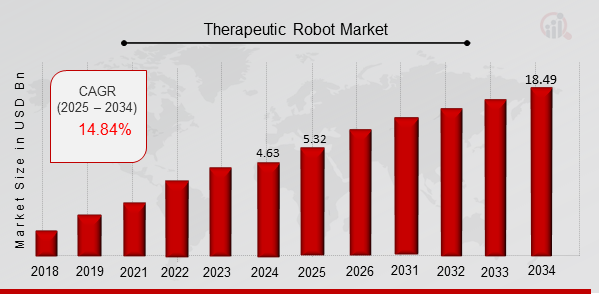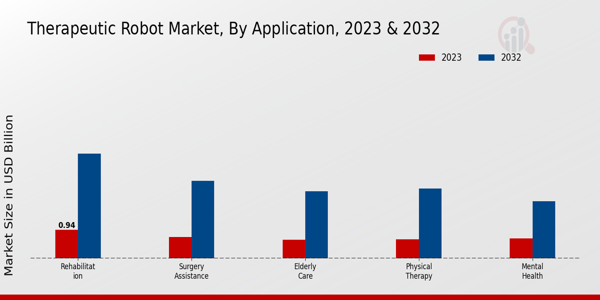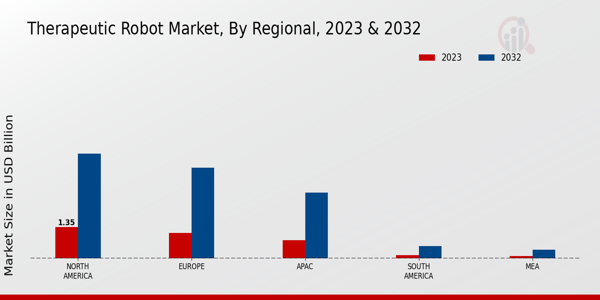Therapeutic Robot Market Overview
As per MRFR analysis, the Therapeutic Robot Market Size was estimated at 4.63 (USD Billion) in 2024. The Therapeutic Robot Market Industry is expected to grow from 5.32 (USD Billion) in 2025 to 18.49 (USD Billion) till 2034, at a CAGR (growth rate) is expected to be around 14.84% during the forecast period (2025 - 2034).
Key Therapeutic Robot Market Trends Highlighted
The Therapeutic Robot Market is driven by an increasing demand for innovative healthcare solutions that can enhance patient care and rehabilitation processes. With a growing emphasis on personalized medicine and the need for efficient patient management, therapeutic robots are proving to be invaluable tools. These robots offer capabilities such as physical therapy assistance, companionship for the elderly, and support for disabled individuals. The integration of advanced technologies, such as artificial intelligence and machine learning, has further accelerated adoption, enabling therapists to deliver more effective and tailored treatment plans.
There are significant opportunities to be explored in sectors like pediatric therapy and mental health support. As the awareness of mental health issues rises, therapeutic robots that can assist in cognitive therapy and social interaction are gaining traction. Additionally, the aging population presents a vital market opportunity, as robots designed for elderly care can enhance the quality of life and independence of senior individuals. Collaborative robots, or cobots, which work alongside healthcare professionals, also present a unique value proposition, opening up new avenues for service delivery.
Recent trends indicate a growing interest in remote healthcare solutions, particularly after the global pandemic highlighted the need for contactless options.The development of robots for teletherapy and remote consultations is becoming increasingly common. Furthermore, the marketplace has seen a rise in user-friendly interfaces that cater to both healthcare providers and patients, ensuring ease of use and acceptance. As technology continues to evolve, the therapeutic robot market is poised to adapt, providing innovative solutions to address the changing needs of healthcare systems worldwide.

Source: Primary Research, Secondary Research, Market Research Future Database and Analyst Review
Therapeutic Robot Market Drivers
Increasing Demand for Automation in Healthcare
The Therapeutic Robot Market Industry is witnessing a significant rise in the demand for automation in healthcare settings, driven by the need for efficient and precise medical solutions. As healthcare systems globally become more complex, the integration of robotic technologies offers an effective means to enhance the quality of care while reducing operational costs. These therapeutic robots can assist with various tasks ranging from rehabilitation to patient monitoring, thereby freeing up valuable time for healthcare professionals to focus on direct patient care.
Moreover, as the aging population continues to grow, there is an increasing demand for assistive technologies that can help in managing the health conditions of elderly patients. This demographic shift is propelling the therapeutic robotics sector, with innovations in artificial intelligence and machine learning driving the development of more sophisticated robots capable of performing a variety of therapeutic functions.
As the Therapeutic Robot Market Industry evolves, hospitals and clinics are more inclined to invest in robotic aids that enhance patient experience, reduce recovery times, and improve overall treatment outcomes, thus further elevating the demand for these innovative solutions.Additionally, advancements in telemedicine and remote patient monitoring are augmenting the growth of therapeutic robots, providing opportunities for healthcare providers to offer more effective care from a distance. The sector is positioned for robust growth as these trends resonate within the industry.
Technological Advancements and Innovations
The Therapeutic Robot Market Industry is being significantly driven by rapid technological advancements and innovations in robotic systems. Ongoing research and development efforts are leading to the introduction of more sophisticated and capable therapeutic robots, enhancing their functionalities and applications in the healthcare space. These advancements not only improve the precision and effectiveness of robots but also contribute to their affordability, making them more accessible to various healthcare facilities.The increasing integration of AI and machine learning algorithms allows therapeutic robots to learn from and adapt to the needs of patients, making therapy more personalized and effective.
Rising Investment in Health Technologies
Growing investment in health technologies is another prominent driver for the Therapeutic Robot Market Industry. Governments and private sectors recognize the potential benefits of robotic therapy and are channeling funds into research and development for innovative healthcare solutions. This influx of capital is stimulating market growth by facilitating the creation of advanced therapeutic robots that can cater to diverse patient needs. As stakeholders continue to prioritize healthcare technology investment, the development of groundbreaking robotic systems is expected to flourish, bolstering the overall therapeutic robot market.
Therapeutic Robot Market Segment Insights
Therapeutic Robot Market Application Insights
The Therapeutic Robot Market, within the Application segment, plays a critical role in the healthcare landscape, encompassing various areas including Rehabilitation, Surgery Assistance, Elderly Care, Physical Therapy, and Mental Health. As of 2023, the total market is valued at approximately 3.51 billion USD, with a notable segmentation that highlights the importance of each area. Rehabilitation stands out as a significant contributor, valued at 0.937 billion USD in 2023 and projected to rise to 3.396 billion USD by 2032.
This domain demonstrates the highest growth potential within the market, driven by increasing demand for advanced technologies that aid in patient recovery outcomes post-injury or surgery, thereby capturing the majority holding of the market share.
Surgery Assistance, valued at 0.692 billion USD in 2023, is also expected to expand significantly, reaching 2.507 billion USD by 2032. The integration of robotic systems in surgical procedures enhances precision and reduces recovery time, marking this segment as crucial for future advancements in surgical techniques. The Elderly Care segment, with a valuation of 0.611 billion USD in 2023, reflects a growing need as the global population ages, rising to 2.183 billion USD by 2032.
This area is particularly significant due to the increasing prevalence of chronic diseases among the elderly, where robots assist in daily activities, ensuring a better quality of life. Physical Therapy, valued at 0.619 billion USD in 2023, is also growing steadily, expected to reach 2.264 billion USD by 2032.
The use of robots in this sector aids in the rehabilitation process by providing structured exercises and motivating patients, thus representing a significant trend in improving outcomes. Meanwhile, the Mental Health sector, valued at 0.652 billion USD in 2023, anticipates growth to 1.86 billion USD by 2032, showcasing the emerging recognition of robotic interventions in providing therapeutic support and companionship to individuals facing mental health challenges. Overall, each segment within the Therapeutic Robot Market segment plays a vital part in catering to specific healthcare needs, demonstrating marked growth trajectories driven by technological advances and societal shifts.
The statistics surrounding the market not only reflect its current stature but also underline substantial opportunities for innovation and enhancement in the delivery of healthcare services. The projected valuations highlight a landscape ripe for development as the medical field increasingly embraces robotic technologies to improve patient care and operational efficiency. As robots continue to integrate into various aspects of healthcare, they hold the potential to reshape the therapeutic landscape significantly, leading to improved patient outcomes and experiences in hospitals and care facilities worldwide.

Source: Primary Research, Secondary Research, Market Research Future Database and Analyst Review
Therapeutic Robot Market End Use Insights
The Therapeutic Robot Market has seen dynamic growth within the End Use segment, which encompasses various applications such as Healthcare Facilities, Home Care, Rehabilitation Centers, and Research Institutions. As of 2023, the market was valued at 3.51 billion USD, showcasing a notable interest in utilizing robots to augment therapeutic interventions across these settings. Healthcare Facilities are significant due to their need for advanced technology to improve patient outcomes and operational efficiency, while Home Care is becoming increasingly crucial as the demand for in-home rehabilitation and elder care rises.
Rehabilitation Centers leverage therapeutic robots to enhance patient engagement and recovery processes, significantly contributing to the overall market growth. Research Institutions also play a pivotal role by exploring innovative approaches in robotic therapy, shaping the future direction of the industry. Collectively, these applications drive the market further, suggesting promising opportunities for development and expansion in the Therapeutic Robot Market, supported by evolving healthcare demands and technological advancements. The segmentation highlights the diverse utility of therapeutic robots and their potential to transform health service delivery.
Therapeutic Robot Market Type Insights
The Therapeutic Robot Market is projected to be valued at 3.51 billion USD in 2023 and is experiencing notable growth across various types, including Exoskeleton Robots, Social Robots, Surgical Robots, and Telepresence Robots. Each of these types plays a crucial role in transforming therapeutic practices. Exoskeleton Robots are essential in rehabilitation, aiding patients with mobility issues to regain their physical abilities, while Social Robots are increasingly used for emotional support in various therapeutic settings, illustrating their growing significance.
Surgical Robots have revolutionized minimally invasive surgeries, enhancing precision and patient outcomes, thereby indicating their vital role in modern healthcare. Additionally, Telepresence Robots provide remote patient interaction, ensuring continuity of care in challenging circumstances. The market's overall segmentation highlights the diverse applications of therapeutic robots, revealing significant growth drivers such as technological advancements and increasing demand for automation in healthcare. However, challenges remain, including high costs and the need for extensive training among healthcare professionals.As these types continue to evolve, the Therapeutic Robot Market statistics reflect a promising trajectory toward a more connected and efficient therapeutic landscape.
Therapeutic Robot Market Technology Insights
The Therapeutic Robot Market within the Technology segment is experiencing significant growth, with a market valuation of 3.51 USD Billion in 2023 expected to reach 12.21 USD Billion by 2032. Various technologies are transforming this market landscape; Artificial Intelligence (AI) plays a crucial role in enabling robots to understand and respond to human emotions, enhancing therapeutic interventions. Machine Learning, which supports AI, allows robots to adapt their functions based on user interactions, thereby improving user experience and therapy outcomes.
Sensors are integral to therapeutic robots, providing critical feedback and data to optimize therapeutic processes. Robotics, the backbone of this market, combines advanced AI and machine capabilities, enabling precise and effective therapeutic solutions. The interconnection of these technologies is paving the way for innovative applications, along with pushing advancements in automation and patient interaction.
The market shows promising trends driven by rising healthcare demand, increased acceptance of robotic solutions, and a growing focus on personalized therapy, presenting ample opportunities despite challenges related to integration and public perception.As the Therapeutic Robot Market data continues to evolve, understanding these technology facets will be essential for stakeholders aiming to capitalize on emerging trends and opportunities in this industry.
Therapeutic Robot Market Regional Insights
The Therapeutic Robot Market is experiencing significant growth across various regional segments. In 2023, North America leads the market with a valuation of 1.35 USD Billion, reflecting advanced technological adoption and a strong healthcare infrastructure. Europe follows closely with a valuation of 1.1 USD Billion, benefiting from an increasing focus on rehabilitation therapies. The APAC region, valued at 0.8 USD Billion, is gaining traction due to rising healthcare investments and an aging population. South America and MEA are at 0.15 USD Billion and 0.11 USD Billion, respectively, indicating emerging opportunities in these markets but comparatively smaller shares.
The growth in North America and Europe highlights their majority holding in the Therapeutic Robot Market segment, primarily due to robust research and development initiatives. Overall, the Therapeutic Robot Market segmentation displays varied growth dynamics, with specific regions striving to enhance therapy delivery and patient outcomes, thereby presenting ample opportunities for innovation and investment going forward.

Source: Primary Research, Secondary Research, Market Research Future Database and Analyst Review
Therapeutic Robot Market Key Players and Competitive Insights
The Therapeutic Robot Market is experiencing substantial growth driven by advancements in robotics technology, increasing applications in healthcare, and rising demand for precision in therapeutic procedures. The competitive landscape is characterized by a diverse range of players, each contributing unique innovations and services aimed at improving patient outcomes and operational efficiency in healthcare settings. Companies are focusing on developing sophisticated robot-assisted therapies that enhance surgical procedures, rehabilitation, and patient care. The integration of artificial intelligence and machine learning with robotic systems is paving the way for enhanced functionality in therapeutic applications.
Moreover, the landscape is evolving with an emphasis on collaborative robots that work alongside healthcare professionals to augment capabilities, reduce errors, and streamline workflows. This environment fosters not only competitive rivalry but also opportunities for collaboration and partnerships among key stakeholders.
Intuitive Surgical stands out in the Therapeutic Robot Market, particularly for its pioneering robotic surgical systems, which have set a benchmark in minimally invasive surgeries. The company's flagship product has demonstrated significant clinical efficacy, leading to quicker recovery times and shorter hospital stays, thus gaining substantial traction among surgeons and healthcare institutions. Intuitive Surgical's strong market presence is bolstered by consistent investments in research and development aimed at advancing robotic technology. The company has successfully cultivated a robust ecosystem, engaging in extensive training programs for surgical teams, thereby enhancing user competency and satisfaction.
Its established reputation and commitment to innovation position Intuitive Surgical as a leader, enabling it to maintain a competitive edge while constantly exploring new therapeutic applications for its robotic systems in surgery and beyond.
Swisslog operates with a distinct focus on automating processes within the healthcare industry, offering solutions that include robotic systems aimed at optimizing hospital logistics. In the Therapeutic Robot Market, Swisslog emphasizes the integration of robotics into patient care workflows, enhancing the efficiency of medication management and patient transport. The company's strengths lie in its ability to customize solutions tailored to specific healthcare environments, thus improving operational productivity while ensuring patient safety. Swisslog's collaborative robots are designed to work seamlessly alongside healthcare staff, alleviating workload pressures and allowing professionals to dedicate more time to patient interactions.
The innovation and customization capabilities of Swisslog's offerings contribute to a unique market position, allowing the company to cater to the evolving needs of healthcare providers looking for advanced robotic solutions to improve therapeutic processes.
Key Companies in the Therapeutic Robot Market Include
Therapeutic Robot Market Industry Developments
The Therapeutic Robot Market has seen significant developments recently, with a focus on advancements in technology and market expansion. Companies like Intuitive Surgical and Stryker Corporation are leading innovations in surgical robots and rehabilitation devices, enhancing patient outcomes. Swisslog continues to make strides in logistics automation for healthcare facilities, streamlining operations. Boston Dynamics and Motional are pushing boundaries in autonomous robots to assist in therapeutic environments.
Notably, ReWalk Robotics has gained traction with its exoskeletons for rehabilitation, catering to individuals with spinal cord injuries. AccuVein, known for its vein visualization technology, is improving patient experiences in procedures. Recent mergers and acquisitions have added momentum to the sector, with various organizations strengthening their market positions to increase efficiencies and broaden their service offerings. The ongoing growth in market valuation for these companies is reflective of increased investments and technological advancements, which are shaping the future landscape of therapeutic robotics and contributing to better healthcare solutions globally.
Overall, the market is evolving rapidly, with collaboration and innovation driving its trajectory.
Therapeutic Robot Market Segmentation Insights
Therapeutic Robot Market Application Outlook
- Rehabilitation
- Surgery Assistance
- Elderly Care
- Physical Therapy
- Mental Health
Therapeutic Robot Market End Use Outlook
- Healthcare Facilities
- Home Care
- Rehabilitation Centers
- Research Institutions
Therapeutic Robot Market Type Outlook
- Exoskeleton Robots
- Social Robots
- Surgical Robots
- Telepresence Robots
Therapeutic Robot Market Technology Outlook
- Artificial Intelligence
- Machine Learning
- Sensors
- Robotics
Therapeutic Robot Market Regional Outlook
- North America
- Europe
- South America
- Asia Pacific
- Middle East and Africa
| Report Attribute/Metric |
Details |
|
Market Size 2024
|
4.63 (USD Billion)
|
|
Market Size 2025
|
5.32 (USD Billion)
|
|
Market Size 2034
|
18.49 (USD Billion)
|
|
Compound Annual Growth Rate (CAGR)
|
14.84 % (2025 - 2034)
|
|
Report Coverage
|
Revenue Forecast, Competitive Landscape, Growth Factors, and Trends
|
|
Base Year
|
2024
|
|
Market Forecast Period
|
2025 - 2034
|
|
Historical Data
|
2020 - 2024
|
| Market Forecast Units |
USD Billion |
| Key Companies Profiled |
Intuitive Surgical, Swisslog, Motional, Boston Dynamics, Stryker Corporation, Omnicare, Fujitsu General, RoboKind, AlterG, Cyberdyne, KUKA, AccuVein, MediTouch, ReWalk Robotics, Haply |
| Segments Covered |
Application, End Use, Type, Technology, Regional |
| Key Market Opportunities |
Aging population needs, Increased mental health awareness, Advancements in AI technology, Growth in rehabilitation services, Rising demand for home healthcare |
| Key Market Dynamics |
Technological advancements in robotics, Increasing demand for elderly care, Growing applications in rehabilitation, Rising health awareness among consumers, Enhanced funding for research initiatives |
| Countries Covered |
North America, Europe, APAC, South America, MEA |
Frequently Asked Questions (FAQ):
The Therapeutic Robot Market is projected to reach a value of 18.49 USD Billion by the year 2034.
The market is expected to grow at a CAGR of 14.84% during the forecast period from 2025 to 2034.
North America is anticipated to dominate the market, reaching a valuation of 4.53 USD Billion by the year 2032.
The Rehabilitation application segment is expected to be valued at 3.396 USD Billion in 2032.
The Surgery Assistance application segment is projected to reach a value of 2.507 USD Billion by 2032.
Major players in the market include Intuitive Surgical, Swisslog, Motional, Boston Dynamics, and Stryker Corporation.
The Elderly Care application segment is expected to be valued at 2.183 USD Billion in 2032.
The Physical Therapy application segment is projected to reach 2.264 USD Billion by 2032.
In 2023, the Therapeutic Robot Market is valued at 0.8 USD Billion for the APAC region.
Key trends include advancements in robotics technology, increasing demand for rehabilitation services, and a growing elderly population.

















